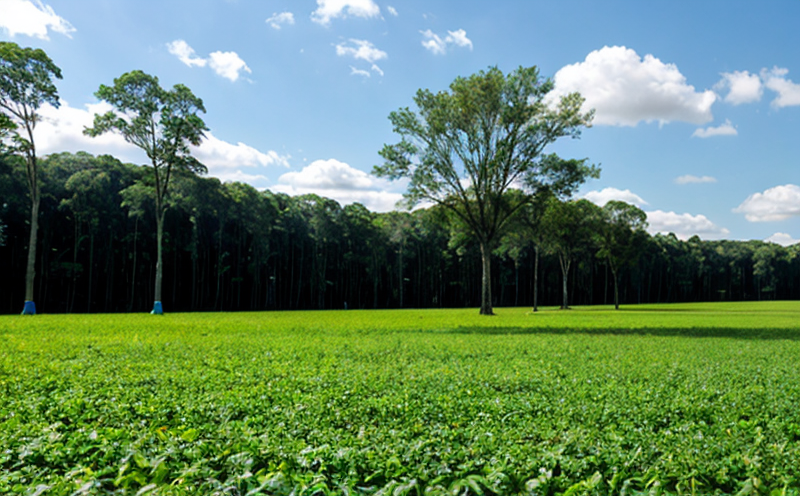Water Consumption Testing in Product Manufacturing
In today's environmentally conscious landscape, understanding and minimizing water consumption during product manufacturing is crucial. Water consumption testing ensures that products are designed with sustainability in mind, optimizing resource use while complying with regulatory standards. This service plays a pivotal role for quality managers, compliance officers, R&D engineers, and procurement teams who seek to implement sustainable practices across their operations.
Water consumption testing involves assessing the amount of water used during various stages of product manufacturing processes. The goal is not only to reduce wastage but also to identify inefficiencies that can lead to cost savings and operational improvements. By conducting this test, companies can make informed decisions about material selection, process optimization, and supply chain management.
The testing process begins with the identification of critical points in the manufacturing cycle where water usage is highest or most vulnerable to wastage. Specimen preparation involves selecting representative samples that accurately reflect typical operating conditions. Once prepared, these specimens are subjected to rigorous testing using state-of-the-art equipment calibrated according to international standards such as ISO 14067:2018 and ASTM E913-15.
Testing methodologies vary depending on the nature of the product being manufactured. For instance, in textile manufacturing, specific attention is paid to dyeing processes, which typically consume large volumes of water. Similarly, in electronics production, focus shifts towards cleaning procedures that involve extensive water usage. Each test aims to quantify the amount of water used per unit produced or processed, providing a clear benchmark against which performance can be measured.
The results of these tests are then analyzed using advanced statistical techniques to ensure accuracy and reliability. Compliance officers use this data to identify areas where adjustments need to be made within existing processes. Engineers leverage it during R&D phases to innovate more efficient manufacturing methods. Procurement teams benefit from insights that help them negotiate better terms with suppliers who offer eco-friendly solutions.
By integrating water consumption testing into their workflows, organizations demonstrate commitment to environmental stewardship and social responsibility. This proactive approach helps build brand reputation among environmentally aware consumers while fostering long-term business sustainability. Compliance with regulations like the EU's Ecodesign Directive further reinforces the importance of such tests in modern manufacturing environments.
Furthermore, water consumption testing supports broader sustainability initiatives by promoting responsible resource management practices throughout supply chains. It encourages collaboration between stakeholders at all levels—from raw material suppliers to final consumers—towards achieving common goals set forth by global frameworks like the United Nations Sustainable Development Goals (SDGs).
Why It Matters
Evaluating water consumption during product manufacturing is essential for several reasons. Firstly, it helps organizations meet increasing public demand for environmentally friendly products and services. Secondly, reducing water usage can translate into significant cost savings through lower utility bills and reduced operational expenses related to water treatment systems.
Water scarcity poses a global challenge that affects businesses operating in diverse geographical locations. By adopting sustainable manufacturing practices that include efficient water use, companies contribute positively towards mitigating this issue. This proactive stance enhances their reputation as responsible corporate citizens, thereby attracting investments from socially conscious stakeholders.
Achieving regulatory compliance is another critical reason for conducting water consumption tests. Many jurisdictions have implemented stringent regulations aimed at reducing industrial water pollution and promoting resource efficiency. Non-compliance can result in severe penalties including fines, shutdown orders, or even criminal charges.
From an operational perspective, minimizing water usage improves overall process efficiency by identifying and addressing leaks, drips, and other sources of wastage. This leads to enhanced productivity levels as machines function optimally without interruptions caused by malfunctioning equipment due to lack of maintenance.
Why Choose This Test
Selecting water consumption testing offers numerous advantages that extend beyond mere compliance requirements. One major advantage lies in its ability to drive innovation within manufacturing processes. Through continuous monitoring and evaluation, companies can discover new ways to optimize water usage leading to improved product quality.
Another significant benefit is enhanced stakeholder trust. Consumers increasingly expect brands to demonstrate transparency regarding their environmental impact. By engaging in rigorous testing practices, manufacturers can build credibility with customers who value sustainability.
The test also facilitates strategic decision-making by providing actionable data that informs investment choices related to technology upgrades or infrastructure improvements aimed at reducing water consumption further.
Additionally, participating in industry benchmarking exercises becomes feasible when accurate measurement tools are employed during testing. Sharing this information fosters knowledge sharing among peers across different sectors contributing collectively towards collective progress.
Use Cases and Application Examples
Water consumption testing finds application across various industries where substantial amounts of water are consumed during production activities. Here are some specific use cases:
- Textile Manufacturing: Assessing dyeing processes to minimize water usage.
- Electronics Production: Evaluating cleaning procedures for printed circuit boards.
- Automotive Industry: Monitoring paint booth operations to optimize water consumption.
- Paper and Pulp Mills: Analyzing wastewater treatment processes for efficiency enhancement.
- Beverage Companies: Studying bottling plants' water usage patterns throughout different seasons.
- Agricultural Equipment Manufacturers: Investigating irrigation systems employed in test fields under varying climatic conditions.
In each case, the primary objective remains consistent: to identify opportunities for reducing water consumption without compromising product quality or operational efficiency. These insights enable manufacturers to implement targeted interventions designed specifically for their unique circumstances.





